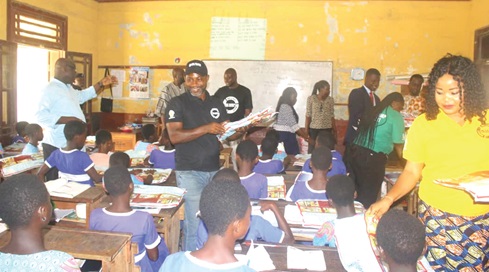
Hundreds of pupils receive treated bed nets in C/R
Hundreds of basic school pupils across the Central Region have received Insecticide Treated Nets (ITNs) as part of efforts to reduce malaria prevalence in the country.
Advertisement
The intervention is part of a grand agenda targeted at helping eliminate malaria in 21 districts in the country by 2028 and from the country eventually.
The Malaria Case Management focal person with the Malaria Elimination Programme, Dr Paul Boateng, said the prevalence of malaria which was around 14 per cent about five years ago was 8.6 per cent last year.
He said the decrease in the prevalence had been consistent over the past few years, and that it was an indication the interventions in the fight against malaria was achieving results.
He observed that while significant gains had been made in the fight against malaria, the prevalence was still worrying, saying as of last year the country recorded a little over five million cases with 151 deaths due to malaria.
Distribution
Last Tuesday, the members of the Parliamentary Select Committee on Health joined staff of the Malaria Elimination Programme, the Ghana Health Service (GHS) and Ghana Education Service staff to the Twifo Hemang Lower Denkyira District and the Cape Coast Metropolis in the Central Region, to distribute the nets.
The team first went to two schools in the district, the Kanaan International School and the Wawase Catholic Basic School and shared the ITNs and then to the Philip Quaque Girls School in Cape Coast.
They also educated the pupils on how to use the nets effectively.
Speaking to the media after the exercise, Dr Boateng said the unit would work with all stakeholders effectively to reduce the prevalence through intensified education and sensitisation activities, to ensure the nets were used for the right purpose.
He indicated that the ITNs and the other interventions being implemented would only be successful if other stakeholders were supportive and committed to achieve the goals and urged all stakeholders to play their roles to ensure the success of the programme.
The Vice Chairman of the Parliamentary Select Committee on Health, Dr Patrick Boakye-Yiadom, who led a team to monitor the exercise in the Central Region, asked the beneficiaries to ensure they slept under the nets and not to keep them as souvenirs.
He particularly cautioned beneficiaries not to use the nets to fish or to fence their gardens.
He stated that the government had spent a lot on the ITN distribution to ensure that the huge malaria disease burden on the country was reduced significantly, and it was only right that beneficiaries of the ITNs used the nets to help the government achieve its goal of reducing the prevalence of malaria.
Dr Boakye-Yiadom, who is also the Member of Parliament for Obuasi East, said the country was making strides in the fight against malaria, explaining that in communities where indoor residual spraying had been done there was evidence that the prevalence had reduced.
The insecticide treated nets is one of the core malaria vector control tools adopted by the Ghana Health Service (GHS) to help reduce malaria prevalence.
The GHS employs varied channels to get nets to benefit the entire households through a mass campaign every three years and continuous distribution in health facilities and schools.
The school ITN distribution happens every year with the exception of years when a mass distribution campaign is undertaken.
Distribution in schools targets pupils in class two and six with the goal of augmenting net quantities in households.




